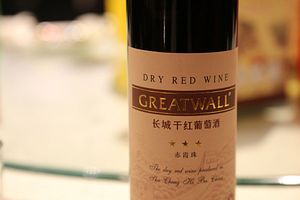China has surpassed France, the world’s foremost producer and exporter of wine, in total acreage, but don’t expect to bring a Ningxia over to a dinner party any time soon.
“I think they largely have the wrong grapes planted,” Geoff Kruth, Chief Operation Officer of the Guild of Sommeliers, a Sonoma-based non-profit, says. “They’re trying to model Bordeaux and plant cabernet – things that may not even really grow well there.”
Production is still on the rise, with China pushing through the ranks from the world’s eighth largest producer of wine in 2013 to the sixth biggest in 2016, due to growing acreage and soaring domestic demand. Wine consumption in China has increased by nearly 45 percent in the past 15 years, and vine planting jumped by 5 percent in 2014 alone, up to a total of 1.97 million acres, according to the International Organization of Vine and Wine. Chinese consumers have an especially discerning palate for red wine. In 2013, China became the world’s largest market for reds, a lucky color in folklore, downing 1.86 billion bottles, moving past France in that category. Per capita consumption is also on the rise.
But many Chinese vineyards aren’t producing wines yet, and much of the acreage dedicated to growing grapes is still used for appetizers and brandy, not wine. The majority of wine producers in Eastern and Western China, where companies in Xinjiang, Ningxia, and Gonsu have had success, produce bulk wine. At times, they’ve been competitive on a global level: in 2011, Jia Bei Lan, a winery in Ningxia, took home a coveted international gold medal for its 2009 Bordeaux blend.
That doesn’t mean those wines are usually a match for their counterparts elsewhere in the world. “From a quality standpoint, no,” Kruth, himself one of 140 master sommeliers in North America, says matter-of-factly. “They have a long way to go before they can compete with American, European, and Australian wines.”
Kruth has contributed to that effort personally: he’ll be leaving for Shanghai in two weeks to represent wines from Oregon and Washington as an educator in China. Part of the process of improving Chinese wines will be encouraging producers to abandon grapes like Cabernet sauvignon, merlot, and malbec, grown in temperate climates with rich soil, for varieties that can grow in the colder, drier western provinces and milder eastern climates.
Chinese customers may still hesitate at the checkout line when better foreign options are available over domestic varieties. “Do I think this is going to be a challenge for European, Australian or other wine-producing regions?” Kruth asks rhetorically. “I really don’t. I think that would be more of a policy or taxation sort of thing.”
China may never become a top-notch wine producer. But in elite circles, good wines, from Argentine malbecs and Napa syrahs to Spanish riojas, have become a calling card, and importers have even begun putting QR codes and holograms on bottles to snuff out fakes. Those are certainly hallmarks of budding aficionados.
































